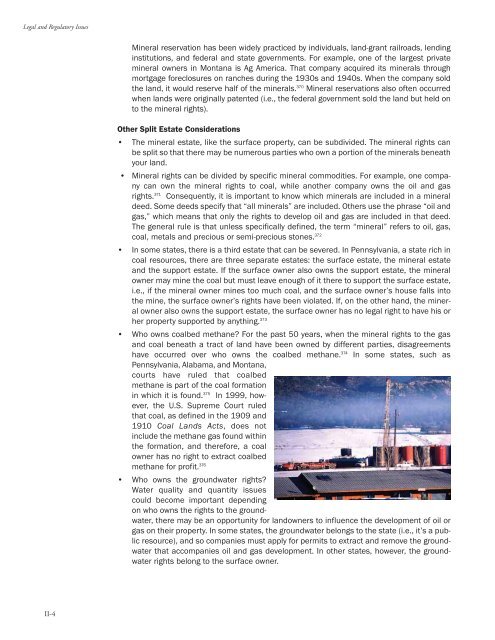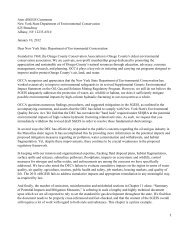Oil and Gas at Your Door? (2005 Edition) - Earthworks
Oil and Gas at Your Door? (2005 Edition) - Earthworks
Oil and Gas at Your Door? (2005 Edition) - Earthworks
Create successful ePaper yourself
Turn your PDF publications into a flip-book with our unique Google optimized e-Paper software.
Legal <strong>and</strong> Regul<strong>at</strong>ory Issues<br />
Mineral reserv<strong>at</strong>ion has been widely practiced by individuals, l<strong>and</strong>-grant railroads, lending<br />
institutions, <strong>and</strong> federal <strong>and</strong> st<strong>at</strong>e governments. For example, one of the largest priv<strong>at</strong>e<br />
mineral owners in Montana is Ag America. Th<strong>at</strong> company acquired its minerals through<br />
mortgage foreclosures on ranches during the 1930s <strong>and</strong> 1940s. When the company sold<br />
the l<strong>and</strong>, it would reserve half of the minerals. 370 Mineral reserv<strong>at</strong>ions also often occurred<br />
when l<strong>and</strong>s were originally p<strong>at</strong>ented (i.e., the federal government sold the l<strong>and</strong> but held on<br />
to the mineral rights).<br />
Other Split Est<strong>at</strong>e Consider<strong>at</strong>ions<br />
• The mineral est<strong>at</strong>e, like the surface property, can be subdivided. The mineral rights can<br />
be split so th<strong>at</strong> there may be numerous parties who own a portion of the minerals bene<strong>at</strong>h<br />
your l<strong>and</strong>.<br />
• Mineral rights can be divided by specific mineral commodities. For example, one company<br />
can own the mineral rights to coal, while another company owns the oil <strong>and</strong> gas<br />
rights. 371 Consequently, it is important to know which minerals are included in a mineral<br />
deed. Some deeds specify th<strong>at</strong> “all minerals” are included. Others use the phrase “oil <strong>and</strong><br />
gas,” which means th<strong>at</strong> only the rights to develop oil <strong>and</strong> gas are included in th<strong>at</strong> deed.<br />
The general rule is th<strong>at</strong> unless specifically defined, the term “mineral” refers to oil, gas,<br />
coal, metals <strong>and</strong> precious or semi-precious stones. 372<br />
• In some st<strong>at</strong>es, there is a third est<strong>at</strong>e th<strong>at</strong> can be severed. In Pennsylvania, a st<strong>at</strong>e rich in<br />
coal resources, there are three separ<strong>at</strong>e est<strong>at</strong>es: the surface est<strong>at</strong>e, the mineral est<strong>at</strong>e<br />
<strong>and</strong> the support est<strong>at</strong>e. If the surface owner also owns the support est<strong>at</strong>e, the mineral<br />
owner may mine the coal but must leave enough of it there to support the surface est<strong>at</strong>e,<br />
i.e., if the mineral owner mines too much coal, <strong>and</strong> the surface owner’s house falls into<br />
the mine, the surface owner’s rights have been viol<strong>at</strong>ed. If, on the other h<strong>and</strong>, the mineral<br />
owner also owns the support est<strong>at</strong>e, the surface owner has no legal right to have his or<br />
her property supported by anything. 373<br />
• Who owns coalbed methane? For the past 50 years, when the mineral rights to the gas<br />
<strong>and</strong> coal bene<strong>at</strong>h a tract of l<strong>and</strong> have been owned by different parties, disagreements<br />
have occurred over who owns the coalbed methane. 374 In some st<strong>at</strong>es, such as<br />
Pennsylvania, Alabama, <strong>and</strong> Montana,<br />
courts have ruled th<strong>at</strong> coalbed<br />
methane is part of the coal form<strong>at</strong>ion<br />
in which it is found. 375 In 1999, however,<br />
the U.S. Supreme Court ruled<br />
th<strong>at</strong> coal, as defined in the 1909 <strong>and</strong><br />
1910 Coal L<strong>and</strong>s Acts, does not<br />
include the methane gas found within<br />
the form<strong>at</strong>ion, <strong>and</strong> therefore, a coal<br />
owner has no right to extract coalbed<br />
methane for profit. 376<br />
• Who owns the groundw<strong>at</strong>er rights?<br />
W<strong>at</strong>er quality <strong>and</strong> quantity issues<br />
could become important depending<br />
on who owns the rights to the groundw<strong>at</strong>er,<br />
there may be an opportunity for l<strong>and</strong>owners to influence the development of oil or<br />
gas on their property. In some st<strong>at</strong>es, the groundw<strong>at</strong>er belongs to the st<strong>at</strong>e (i.e., it’s a public<br />
resource), <strong>and</strong> so companies must apply for permits to extract <strong>and</strong> remove the groundw<strong>at</strong>er<br />
th<strong>at</strong> accompanies oil <strong>and</strong> gas development. In other st<strong>at</strong>es, however, the groundw<strong>at</strong>er<br />
rights belong to the surface owner.<br />
II-4




